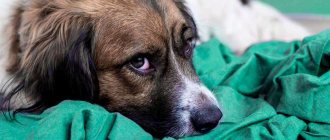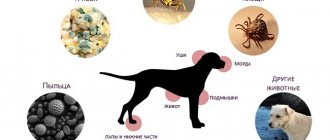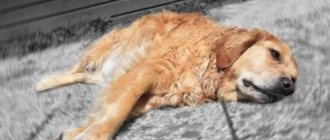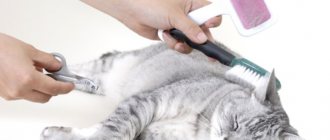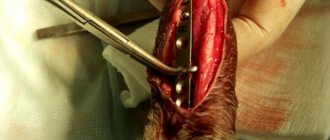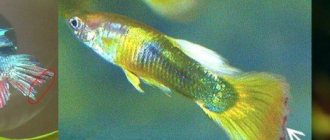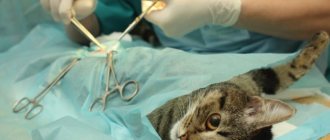Unfortunately, not one cat is immune from the appearance of lichen. The cause of the disease may be pathogenic microorganisms or allergic reactions. In the first case, long-term treatment will be required under the supervision of a veterinarian; in the second, diet correction and elimination of the allergen help.
Any cat can become infected with lichen, but most often young, old or weakened animals are affected. Strong immunity helps the body fight all kinds of diseases, including lichen, but does not protect pets 100%. Even cats that have never left the apartment can get sick, because the infection can be brought from the street on shoes. For the same reason, you should not allow contact with street animals and, upon returning home, wash your hands, clean your shoes and clothes.
Many lovers of four-legged animals simply do not know how to identify the disease and how to treat a cat if it has lichen. But it is important to remember that an accurate diagnosis and treatment can only be prescribed in a veterinary clinic.
Types of lichen in cats
Depending on the cause, there are several types of lichen - pink, multi-colored, weeping or ringworm. Symptoms of manifestation have similar features and sometimes it is possible to distinguish one type from another only in a veterinary clinic. Ringworm is caused by microorganisms such as yeast-like fungi Pityrosporum, Trichophyton (trichophyton), Microsporum gypseum or Microsporum canis. But sometimes the disease develops due to an animal’s allergy to food components, detergents, dust and other irritants to which cats are susceptible.
The incubation period is always different and depends on the general condition of the animal and many associated factors. Fleas, worms, lice and other parasites, as well as any diseases that weaken the body’s natural defenses, can contribute to the development of the disease. Sometimes fungal spores can “sleep” for years on a cat’s fur, in carpet pile, on upholstered furniture and other furnishings.
Ringworm
This type of lichen is considered the most dangerous and difficult to cure. The incubation period lasts on average from 7 to 14 days; in rare cases, the first symptoms may appear on days 20-25. The pathogens are resistant to external influences and can remain active for several years. Once in the soil, the fungus “falls asleep” and is not affected by increases or decreases in temperature, sunlight or humidity. Trichophytosis and microsporia spores are resistant to many chemical disinfectants, so treatment often takes months.
Ringworm is dangerous to humans and is transmitted both through direct contact with a sick animal and through contact with contaminated household items. Therefore, during treatment, veterinarians advise isolating the cat and observing quarantine measures.
A cat can become infected through direct contact with a sick animal, an object inseminated with spores, and while walking in an infected area. The disease can be transmitted by fleas, mosquitoes and other blood-sucking insects, and a cat can also become infected with lichen from rodents.
Cases of latent carriage are quite rare; usually symptoms appear even in cats with strong immunity.
Treatment for lichen is complex and lengthy. In the initial stages, ointments and special shampoos can help; in more severe situations, complex therapy is required. It is highly undesirable to carry out independent treatment and interrupt the prescribed course, since ringworm can “fall asleep” for a while and then reactivate with renewed vigor. All potent medications must be prescribed by a veterinarian.
Ringworm
Ringworm can appear on a cat's body for several reasons. This is usually associated with hormonal disorders or allergies, but sometimes the disease occurs when pathogenic microorganisms are activated. The disease is not transmitted to other animals or humans, but in advanced cases it can cause irreparable harm to the health of the cat.
Characteristic signs of weeping lichen:
- at the beginning of the disease, small pink spots appear on the cat’s skin;
- then the spots on the skin grow and begin to become wet;
- the animal is worried, scratches, licks the affected areas;
- small bubbles with clear liquid form inside the spot; in advanced cases, when an infection occurs, the bubbles are filled with pus;
- the temperature of the affected area is higher than the cat’s body temperature;
- If left untreated, the blisters burst, and the fluid infects healthy tissue, which contributes to the formation of new foci of infection.
With timely treatment, the blisters resolve within 7–14 days. The skin becomes covered with a dense crust, which quickly falls off. Treatment is prescribed by a dermatologist after appropriate tests. Drying ointments with an antibacterial effect are usually used. In severe cases, complicated by inflammatory processes and purulent discharge, antibiotics and restorative drugs are prescribed.
Pityriasis versicolor
Pityriasis versicolor or pityriasis versicolor is caused by the fungus Malassezia (Pityrosporum), which is a resident (normal) skin microbiota. That is, the causative agents of the disease almost always live on the skin and fur of the animal and are activated only when the immune system is weakened. It is possible to become infected with this type of lichen from a cat, but clinical signs will only appear if the person has a weakened immune system or has other concomitant diseases.
Characteristic features:
- irregularly shaped bald patches appear on the skin of animals;
- the skin at the affected sites may be yellow, brownish, pink, white or grayish;
- small spots, if left untreated, gradually merge into large lesions;
- the surface of the spots may be smooth or covered with small scales;
- when it gets on the claws, the fungus deforms the outer and inner layers causing curvature and delamination;
- There is practically no skin itching, so the animal rarely scratches the affected areas.
Ringworm is usually found in warm, moist areas of the animal's body, such as the nose, groin, armpits, ears, and abdomen.
To treat pityriasis versicolor, restorative drugs, antifungal ointment and tablets are prescribed. In advanced cases, treatment can last from 1 to 4 months.
You should also know that lichen versicolor often “falls asleep”, but does not go away completely. Therefore, when immunity is weakened, relapses are possible.
Pityriasis rosea
The causes of pityriasis rosea can be infections or allergies. Usually only weakened animals with poor immunity become infected. Allergic lichen is inherited and may not appear in a healthy cat throughout its life.
Characteristic features:
- small bald spots form on the cat’s neck, back or chin;
- the skin in the lesions turns pink and itches;
- the spots have clear contours, sometimes ridges form on the border of healthy and affected skin;
- combed areas become covered with scabs;
- As the disease progresses, the lesions enlarge and merge.
Treatment should be aimed at restoring immunity. Drug treatment, as with other lichens, is not practiced. When the cat’s condition is normalized, pityriasis rosea goes away in 1–2 months.
If you let the disease take its course, scabs will form in the areas where you scratched. Open wounds from scratching can become infected, causing inflammation and worsening the cat's condition.
The disease is not contagious and does not threaten the health of other pets or humans. An exception may be people or animals with extremely low immunity, but such cases are very rare.
During treatment, you cannot bathe or walk the animal. Water and direct sunlight can aggravate the disease and slow down recovery.
What is ringworm
Ringworm (otherwise known as microsporia, trichophytosis) is a contagious fungal disease characterized by skin lesions.
Sources of infection are other sick animals. Transmission factors are any surface or object, even food, that has previously been touched by a sick animal.
Dermatophyte fungi reproduce by spores that remain viable for two years.
The incubation period lasts up to three months. The pathogens take root on the skin of the animal, feeding on the epithelium.
The disease primarily appears on the head, tail and paws. It spreads throughout the animal's body rapidly.The advanced form of the disease is called generalized. This stage develops when the cat is treated incorrectly or completely untreated.
This disease affects adults with weak immunity, kittens up to one year old, and artificially raised breeds that do not have immunity to lichen.
If your pet has a strong, healthy body, the disease may be easier or it may become a carrier of the disease.
But even with a slight decrease in immunity, the development of ringworm is possible.
When treating microsporia, it is important to identify the underlying disease, which suppresses the animal’s immunity and prepares the ground for the progression of fungi.
What does ringworm look like in cats?
It is difficult to distinguish lichen from other skin diseases, but it is possible. First of all, it is worth excluding allergic scratching, severe parasitic infestations, injuries, burns and dermatitis.
Ringworm:
- bald spots with jagged edges appear on the cat’s body;
- the location is not clear, the hair around the lesion is brittle and heterogeneous;
- the skin at the site of the lesion is smooth, scratches or scabs are rarely visible.
Ringworm:
- small spots appear on the cat’s skin and grow rapidly;
- bubbles with clear liquid form in the lesions;
- lichen is accompanied by itching, so the animal scratches the affected areas;
- with secondary infection, purulent discharge appears;
- the skin and fur around the fire are moist.
Pityriasis versicolor:
- one or more multi-colored areas without fur are noticeable on the skin;
- the color of the spots may be yellowish, gray, brown or white;
- the skin is smooth or covered with small scales.
Pityriasis rosea:
- lesions from 0.5 to 2 cm;
- smooth outline, pink skin;
- When scratched, scabs form.
For a more accurate diagnosis, you need to contact a veterinary clinic.
Symptoms
The disease develops gradually, first affecting small skin areas. What ringworm looks like can be clearly seen in the photo: the hair on the affected areas falls out, as if molting, the skin is inflamed and softened. The main places of initial localization of lichen are the head and ears, sides and base of the tail. Then the lichen spots grow, and in advanced cases they can cover almost the entire body of the animal. It appears as if the cat's fur was shaved, hence the name of the disease.
One of the difficult to tolerate manifestations of dermatomycosis is severe itching. Oily scaly crusts form on areas of the skin damaged by the fungus. The cat constantly scratches them, transferring dermatophyte spores to the microscratches that form in neighboring areas.
The disease can occur in different forms:
- superficial (external) - manifested by focal alopecia (hair loss in certain areas).
- deep - characterized by damage to all layers of the skin and can cause severe, sometimes purulent, inflammation.
- erased - differs in that fungal spores are concentrated in small but numerous local zones, so it is extremely difficult to destroy them.
Although the signs of dermatomycosis are quite clear, other skin diseases have similar symptoms: allergic dermatitis, eczema, alopecia of various origins. Therefore, only a veterinarian can prescribe the correct treatment after a differential diagnosis of the disease has been carried out.
Symptoms and how to identify ringworm in a cat
Depending on the nature of the disease and the course of the disease, clinical signs may vary. But the main external sign of deprivation is rounded bald patches.
The first symptoms of lichen in a cat may appear as early as four days after contact with an infected animal or object. In four-legged animals with strong immunity, signs of the disease can be detected only after several months, and the clinical picture is often blurred without pronounced symptoms.
Main (general) features:
- localized baldness;
- skin pigmentation;
- inflammation, redness, whitish coating;
- increased local temperature;
- peeling, scaliness;
- itching, pain reactions;
- bubbles with clear or yellowish-green liquid at the site of bald patches;
- an inflamed ridge along the border of healthy skin;
- scabs, scratches, matted fur.
Veterinarians recommend regular preventive examinations of cats. Owners should consult a doctor if the cat is constantly itching, nervous, has trouble eating, or does not play its usual games.
Sometimes the disease occurs secretly without the appearance of external symptoms. Accordingly, the owner does not suspect anything, since, at first glance, nothing bothers the cat. With this course, the disease often becomes chronic and difficult to treat.
Typically, the chronic form develops when infection enters from the external environment through contact with infected animals. Often found in long-haired pets, as well as cats with strong immunity and good heredity.
Read also
Ear mites in cats: signs and treatment
The appearance of a parasite such as ear mites in a cat is the beginning of a serious disease that must be eradicated at the first symptoms.
Worms in cats: symptoms, signs and treatment
The first signs of infection may be absent for some time or resemble manifestations of other diseases
Sterilizing a cat: at home or in the clinic?
Sterilization is an intervention as a result of which an animal (a cat in particular) loses its ability to reproduce
Symptoms and signs of rabies in a cat
A person becomes truly afraid only when a cat bites him until he bleeds.
Washing a cat: how to properly bathe an animal?
Many people know that bathing a cat can be difficult due to the animal’s excessive aggressiveness. Tabby pets have an innate fear of water, so when bathing
Determination of ringworm with a Wood's lamp
Most types of lichen caused by fungus are determined using a Wood's lamp. The spores glow under the lamp with a bright green fluorescent color. The cat is brought into a dark room and ultraviolet light is directed at it.
Before the procedure, you should not treat the affected areas with ointments or powders, as this may complicate the diagnosis. The fact is that some medications also glow green when exposed to ultraviolet light.
You should also know that not all types of fungus can be determined using a Wood's lamp. For some species, you will have to take an analysis and do a culture. This method gives almost 100% results, but takes from several weeks to a month, since the spores grow for a very long time.
Effective drugs for treating lichen in cats
At the first symptoms of lichen, you should contact a veterinary clinic. The doctor will conduct the necessary tests, take samples, make a diagnosis and prescribe treatment. Self-medication is extremely undesirable, as there is a risk of simply “healing” the cat. It should also be remembered that fungal forms often go into long-term hibernation and will appear again when the immune system is weakened.
At the initial stage, topical drugs are usually used. Various ointments and sprays that help relieve itching, inflammation and eliminate fungal lesions.
In more complex cases, local therapy is combined with oral antifungal drugs.
Tablet antifungal drugs:
- Griseofulvin;
- Intraconazole;
- Terbinafine;
- Veto Wedge;
- Ketoconazole.
In addition to antifungal drugs, a veterinary dermatologist must prescribe immunostimulants, vitamin and mineral complexes, and also give recommendations on feeding and keeping the cat.
The reaction of pets to the use of drugs is always different and depends not only on the individual susceptibility of the animal, but also on the type of lichen. Therefore, the course of treatment is prescribed individually for each cat.
The course of taking individual medications for lichen, as well as the use of ointments, can last from 2 weeks to several months. You cannot interrupt treatment on your own, since untreated lichen will relapse as soon as you stop taking the medications.
During the treatment process, it is necessary to visit the attending physician so that he can examine the cat, track the dynamics and, if necessary, make course adjustments.
Vaccination:
- Vakderm F;
- Microderm;
- Polivak-TM.
Along with other medications, veterinarians often prescribe vaccinations. In Russia, lichen vaccines are used for both treatment and prevention.
Treatment
For mild forms of the disease, especially if the cat is a short-haired breed, antifungal ointments or sprays can be used:
- Miconazole,
- Thiabendazole,
- Fungin,
- Sanoderm,
- Fukortsin,
- Ointment Yam.
A good result is achieved by combining external preparations with baths of lime sulphide solution. True, the animal’s fur after such a bath becomes yellowish, and the smell of this drug is very unpleasant.
In severe cases of dermatomycosis, if baths and external treatments do not work, the veterinarian may prescribe oral medications for the cat. Veterinarians consider the antibiotic Griseofulvin and the antifungal agents Intraconazole or Terbinafine to be the most effective medications for dermatomycosis. The dosage and duration of treatment is calculated individually.
Attention! A cat owner should keep in mind that treatment for his pet for ringworm can take up to a month and a half. This is explained by the high viability of the dermatophyte fungus; it is difficult to completely destroy its spores, and even a minimal number of surviving spores means a chance of relapse of the disease.
How to treat ringworm in cats at home
At home, only pityriasis rosea or pityriasis versicolor can be treated in the early stages. Traditional methods are not very effective in treating ringworm or weeping lichen, but are justified if the cat has contraindications to drug treatment.
Folk remedies:
- aloe juice with olive oil in a 1:1 ratio;
- celandine for treating wounds;
- iodine solution;
- a mixture of warm lemon juice and olive oil. Used in the form of compresses.
All of the methods listed cannot give a 100% guarantee, so you should contact a veterinary clinic as soon as possible.
Where does it most often appear?
Usually the disease is localized on the head, ears, muzzle of the animal, on its limbs or tail.
By scratching the infected areas, the cat spreads the infection throughout the body - if treatment is not started in time, the disease will spread over most of the animal's skin.
Perhaps the cat does not have lichen, but baldness.
Diagnosis of the disease
If you have any skin diseases or suspicion of ringworm in your pet cat, you should immediately take your pet to a veterinarian. Only a specialist can diagnose the pathology and prescribe the correct treatment.
What does ringworm look like in cats?
Above the eye Behind the ear Photo - what lichen looks like on a cat’s back
In a veterinary clinic, the diagnosis is confirmed using fluorescent (under a lamp), microscopic and cultural (bacterial culture) studies.
Ointment for ringworm in cats
To treat lichen in cats, complex therapy is used, which necessarily includes ointments. But all appointments must be coordinated with a veterinarian after tests and tests. Some components can only aggravate the situation, and the use of drugs before diagnosis can blur the picture.
Before treatment, the affected areas are washed with a cotton swab or disk soaked in warm water or chlorhexidine. Remove scabs and crusts, and also clean adjacent fur. In some cases, the hair around the spot is cut off. The affected area is dried and only then the ointment is applied, covering healthy areas by 1–2 cm.
Clotrimazole has anti-inflammatory and antifungal effects and is used to treat affected areas of the skin with weeping and ringworm. The ointment is applied in a thin layer to the skin two or three times a day. The course of treatment is at least a week; if necessary, the drug is used for 2–3 weeks. Repeated treatments are recommended after three weeks.
Sulfur ointment is used in the treatment of various forms of lichen. A small amount of ointment is applied to the affected skin, covering 1–2 cm of healthy skin. The course of treatment is from 10 to 20 days.
YAM BK ointment has a pronounced antifungal and antiseptic effect. The drug is applied to the skin in a thin layer (it is not necessary to remove crusts and scabs) 1-2 times a day for a week. In case of relapses, the course of treatment is repeated.
Terbinafine is used to treat fungal skin diseases caused by dermatophytes and lichen versicolor. The ointment is applied to the affected areas 2-3 times a day for 10-14 days. If necessary, the course is repeated after 14 days.
When using any ointments, it is necessary to protect the animal. Cats often lick medications, so you need to use a special collar.
Diagnostics
Since the symptoms of lichen are similar to other skin lesions, the disease can only be recognized using laboratory and instrumental methods:
- Luminescent. Under a source of ultraviolet radiation of a certain range (Wood's lamp), a characteristic green glow is observed in hair affected by ringworm. In 50% of cases of deprivation, the method is ineffective: if only the root part of the hair is affected, the glow is imperceptible, and trichophytosis does not cause a glow. In addition, the hair can continue to glow even after the death of the fungus.
- Microscopic examination of the scraping. Wool and wool scales are examined under a microscope, revealing mycelium and spores of the fungus. Detects ringworm and pityriasis versicolor.
- Mycological sowing. A culture grown on a nutrient medium after sowing is examined under a microscope. The most reliable method that identifies all mushrooms, but the result is ready in 10-14 days.
- General blood analysis. It is used to diagnose tinea versicolor, characterized by an increased level of eosinophils.
Ringworm from cats to humans and children
Not all types of lichen are contagious, so before you panic, you need to find out what kind of disease has affected your pet. Contagious include ringworm and, to a lesser extent, tinea versicolor. The rest are practically not dangerous for adults, children and other pets.
You can become infected with ringworm through direct contact with a sick animal or object. It is important to remember that fungal spores are quite tenacious, so they can “sleep” for years in the soil, on clothes, wool or furnishings.
A cat can catch lichen by playing on the street where a sick animal has passed, from common care items, bowls or toys. Fungal spores can be found in skin flakes, hair follicles or dandruff.
The disease usually affects older people, children, and people with weakened immune systems.
Wounds, eczema, dermatitis and other skin defects can provoke infection into the human body.
After the first symptoms of the disease appear, you must immediately consult a doctor and take the cat to an appointment with a veterinarian. Timely treatment will help stop lichen at an early stage and prevent the disease from spreading. It is important to observe quarantine measures and prevent contact between infected and healthy people and animals.
Disease prevention
Veterinarians recommend avoiding any contact with foreign animals, and also thoroughly washing your hands after going outside. It is necessary to clean clothes, shoes, clean the apartment with special disinfectants, and also do not skip preventive examinations of the cat at the veterinary clinic.
It is recommended to wash your paws after every walk, even in a relatively safe area. Solutions of chlorhexidine and miramistin help well; they are safe for cats, but harmful to fungal spores.
It is important to monitor the health of your beloved cat and not skip vaccinations. But before using the vaccine, you must consult a doctor, as there are contraindications. The pet's diet should be balanced and nutritious.
Basically, all preventive measures are aimed at maintaining health and developing strong immunity in the cat. It is important to remember that a healthy animal gets sick much less often, and a strong body successfully resists almost any external influences of pathogenic microflora.


